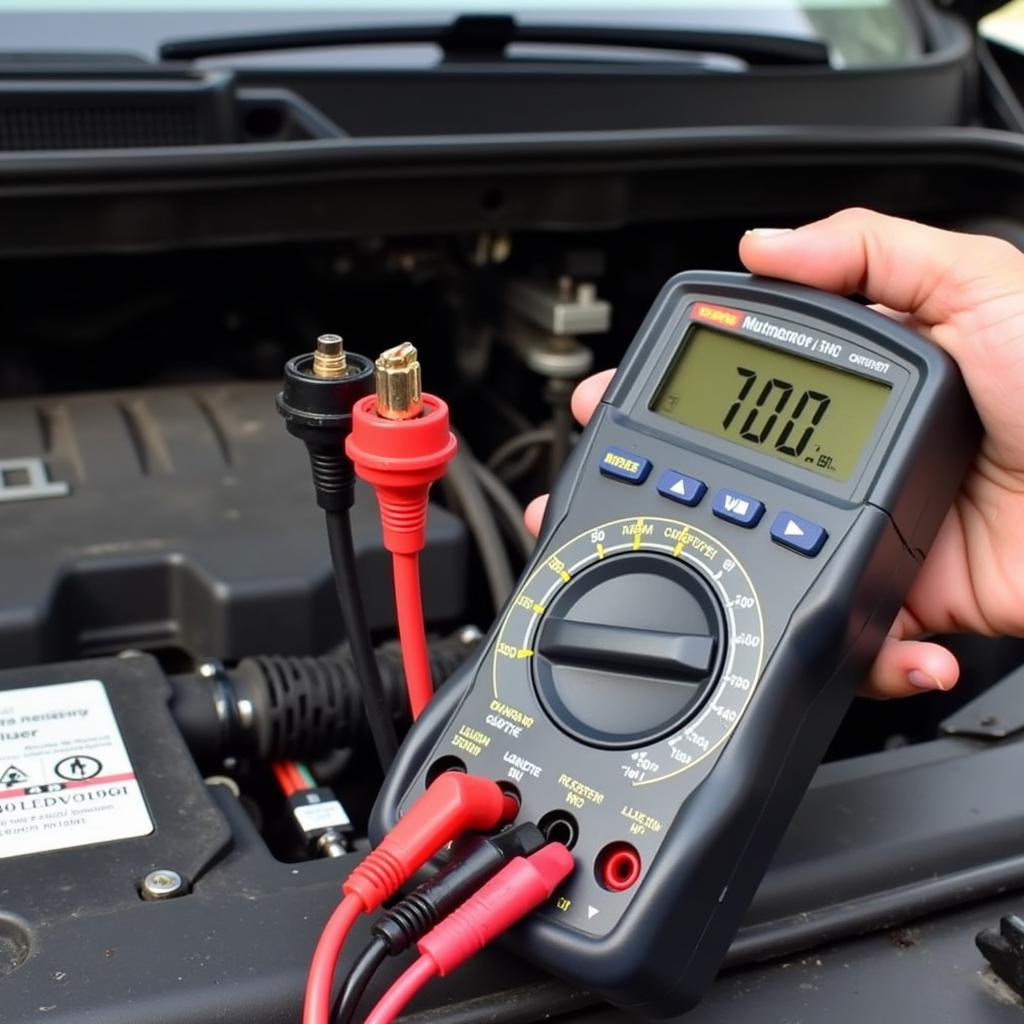A dead car battery is frustrating, especially when it seems to happen out of the blue. Often, the culprit is a parasitic draw, a sneaky electrical drain that occurs even when the car is off. A multimeter parasitic draw test is the best way to pinpoint the source of this power drain. Let’s explore how to perform this test and reclaim your battery’s power. finding parasitic draw with multimeter
Understanding the Multimeter Parasitic Draw
What exactly is a parasitic draw? It’s the current that flows from your car battery when the ignition is off. While some draw is normal, an excessive draw can drain your battery overnight, leaving you stranded. The multimeter parasitic draw test helps you identify these excessive drains. A common misconception is that a parasitic draw is always a major electrical fault. Sometimes, it can be as simple as a glove box light staying on, a forgotten dome light, or a faulty relay.
 Testing car battery for parasitic draw
Testing car battery for parasitic draw
How to Perform a Multimeter Parasitic Draw Test
Before we begin, safety first! Make sure your car is parked on a level surface, the engine is off, all lights are switched off, and the doors are closed. Also, ensure the key is removed from the ignition to eliminate any key-off draw.
- Gather your tools: You’ll need a digital multimeter with a 10A DC current setting and an appropriate fuse, rated slightly higher than the expected draw. parasitic draw multimeter
- Prepare the multimeter: Set your multimeter to the 10A DC current range.
- Disconnect the negative battery cable: Carefully remove the negative cable from the battery terminal.
- Connect the multimeter: Connect the multimeter’s red lead to the negative battery cable and the black lead to the negative battery terminal. The multimeter is now in series with the battery and will measure the current flow.
- Observe the reading: The multimeter will display the parasitic draw in amps.
- Interpret the results: A reading of 50 milliamps (0.05 amps) or less is generally acceptable. Anything significantly higher indicates a problem.
Identifying the Culprit Circuit
If the draw is excessive, start pulling fuses one by one while observing the multimeter reading. When the reading drops significantly, you’ve isolated the circuit causing the problem. Refer to your owner’s manual to identify the components on that circuit. “Remember, patience is key during this process,” advises John Smith, Senior Automotive Electrical Engineer at AutoElectric Solutions. “Don’t rush the process and double-check your readings.”
Common Causes of Excessive Parasitic Draw
- Faulty alternator diodes: A bad diode in the alternator can allow current to leak back into the electrical system.
- Stuck relays: Relays are electromechanical switches that control various electrical components. A stuck relay can cause a continuous draw.
- Interior lights: A dome light, glove box light, or trunk light that stays on can drain your battery surprisingly fast.
- Faulty aftermarket accessories: Incorrectly installed or malfunctioning aftermarket accessories can be a significant source of parasitic draw.
- Bad wiring or corroded connections: Damaged wiring or corroded connections can create unintended electrical paths, leading to a parasitic draw.
What is an Acceptable Parasitic Draw on a Car Battery? acceptable parasitic draw on car battery
A healthy car battery should have a parasitic draw of no more than 50 milliamps (0.05 amps). While some newer vehicles might have slightly higher acceptable draws due to more complex electronics, anything significantly above this threshold warrants investigation. “A small, consistent drain over time can be just as damaging as a large, intermittent one,” says Maria Garcia, Lead Diagnostic Technician at Advanced Auto Diagnostics. “Regularly checking your battery’s health can prevent unexpected breakdowns.” If you’re unsure, consulting a qualified automotive electrician is always recommended.
Conclusion
parasitic test battery Mastering the multimeter parasitic draw test empowers you to identify and address the silent killer of car batteries. By following these steps, you can diagnose and rectify excessive parasitic draw, ensuring your car starts reliably every time. Don’t let a dead battery ruin your day—take control with a multimeter and battery draw test with test light.
FAQ
- What is a parasitic draw? A parasitic draw is a small current drain from your car battery when the ignition is off.
- What are the symptoms of a parasitic draw? The most common symptom is a dead battery, especially after the car has been parked for a while.
- How do I test for a parasitic draw? Use a digital multimeter to measure the current flow from the battery when the car is off.
- What is an acceptable parasitic draw? Typically, 50 milliamps or less.
- What are the common causes of parasitic draw? Faulty alternator diodes, stuck relays, interior lights, aftermarket accessories, and bad wiring.
- Can I fix a parasitic draw myself? Depending on the cause, you may be able to fix it yourself. However, for more complex issues, consult a professional.
- How can I prevent parasitic draw? Regular maintenance, proper installation of accessories, and addressing any electrical issues promptly can help prevent parasitic draw.

